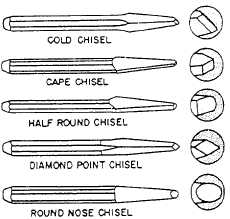Socket Handles
There are four types of handles used with these
sockets. (See fig. 2-5) Each type has special advan-
tages, and the experienced worker chooses the one
suited for the job at hand. The square driving lug on
the socket wrench handles has a spring-loaded ball
that fits into a recess in the socket receptacle. This
mated ball-recess feature keeps the socket engaged
with the drive lug during normal usage. A slight pull
on the socket, however, disassembles the connection.
RATCHET.— The ratchet handle has a reversing
lever that operates a pawl (or dog) inside the head of
the tool. Pulling the handle in one direction causes the
pawl to engage in the ratchet teeth and turn the socket.
Moving the handle in the opposite direction causes
the pawl to slide over the teeth, permitting the handle
to back up without moving the socket. This allows
rapid turning of the nut or bolt after each partial turn
of the handle. With the reversing lever in one position,
the handle is used for tightening. In the other position,
it is used for loosening.
HINGED HANDLE.— The hinged handle is also
very convenient. To loosen tight nuts, swing the han-
dle at right angles to the socket. This gives the greatest
possible leverage. After loosening the nut to the point
where it turns easily, move the handle into the vertical
position, and then turn the handle with the fingers.
SLIDING T-BAR HANDLE.— When using the
sliding bar or T-handle, the head can be positioned
anywhere along the sliding bar. Select the position
that is needed for the job at hand.
SPEED HANDLE.— The speed handle is
worked like the wood-worker’s brace. After the nuts
are first loosened with the sliding bar handle or the
ratchet handle, the speed handle can be used to re-
move the nuts more quickly. In many instances the
speed handle is not strong enough to be used for
breaking loose or tightening the nut. The speed socket
wrench should be used carefully to avoid damaging
the nut threads.
Accessories
To complete the socket wrench set, there are sev-
eral accessory items. Extension bars of different
lengths are made to extend the distance from the
socket to the handle. A universal joint allows the nut
to be turned with the wrench handle at an angle.
Universal sockets are also available. The use of uni-
versal joints, bar extensions, and universal sockets in
combination with appropriate handles makes it possi-
ble to form a variety of tools that will reach otherwise
inaccessible nuts and bolts.
Another accessory item is an adapter that allows
you to use a handle having one size of drive and a
socket having a different size drive. For example, a
3/8- by 1/4-inch adapter makes it possible to turn all
1/4-inch square drive sockets with any 3/8-inch
square drive handle.
HACKSAW
The hacksaw is a handy portable metal cutting
tool that can be used for cutting sheet metal, bolts, and
pipe. A hacksaw cuts on the push stroke only; the
blade should be installed in the frame with the teeth
facing away from the handle. Figure 2-1, view H,
shows two types of hacksaws with the blade in the
proper position.
CHISELS
Chisels are tools that can be used for chipping or
cutting metal. They will cut any metal that is softer
than the materials of which they are made. Chisels are
made from a good grade tool steel and have a hard-
ened cutting edge and beveled head. Cold chisels are
classified according to the shape of their points, and
the width of the cutting edge denotes their size. The
most common shapes of chisels are flat (cold chisel),
cape, round nose, and diamond point (fig. 2-7).
Figure 2-7.—Types of points on metal cutting chisels.
2-5



